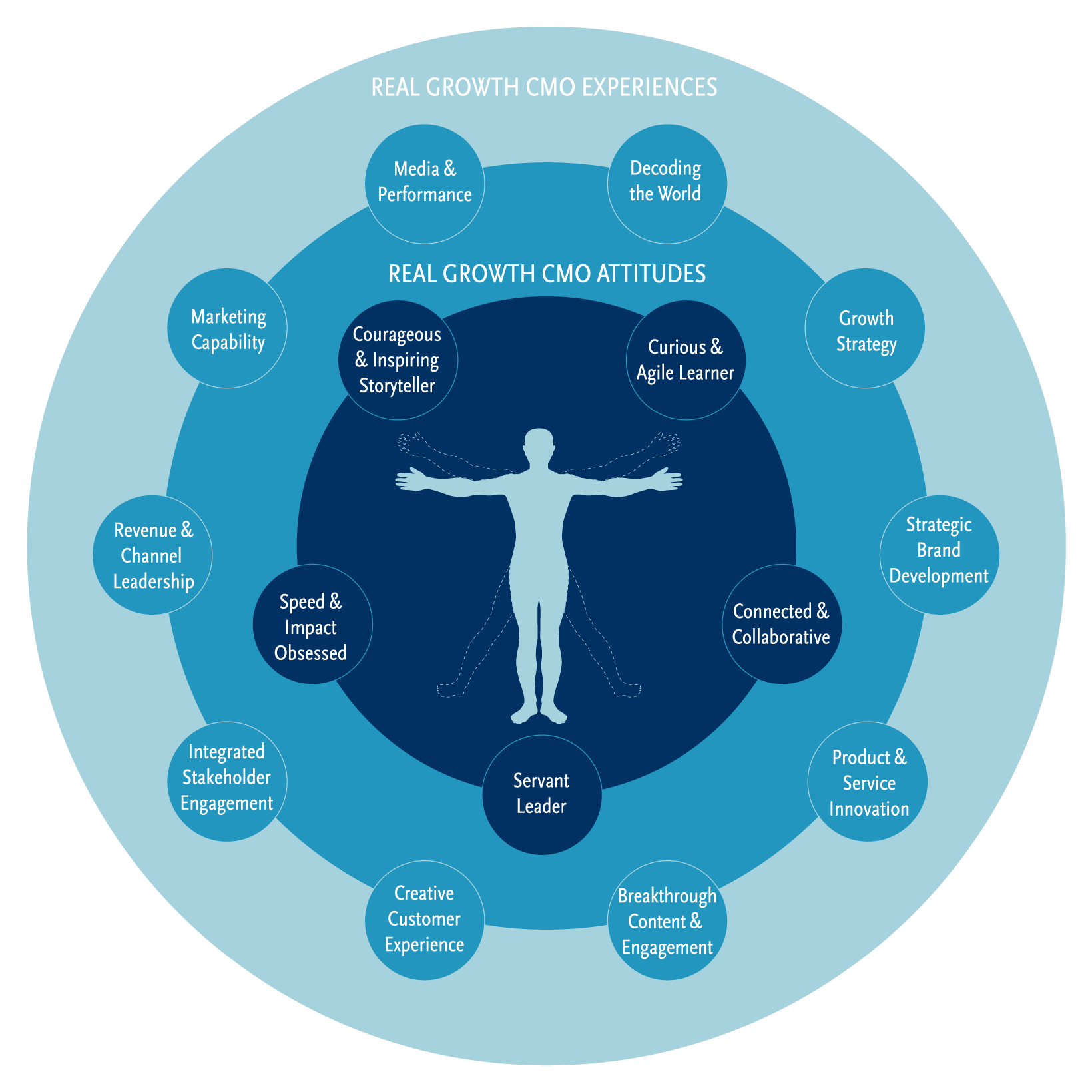The COVID-19- crisis has revealed that the strongest companies and leaders are those that are purposeful and confident about their role in society. The businesses that are exceeding expectations are winning because they prioritize understanding the needs of, and creating value for, all their stakeholders, including colleagues, consumers, communities and the capital markets.
The da Vinci Growth CMO profile
The Institute for Real Growth (IRG) and Spencer Stuart’s Marketing, Sales & Communications Practice interviewed more than 500 leaders worldwide about leadership and performance. The study identifies a group of over-performing CMOs, whom we refer to as “da Vinci Growth CMOs.” These high-performing CMOs understand that unleashing the power of technology is critical to success and requires both data and human creativity. They also understand sustained business growth requires the organization to create value for all stakeholders, and that human-centric growth strategies deliver superior shareholder returns.
As part of our study, we identified the 10 most important CMO areas of experience and the five essential attitudes of over-performing marketing growth leaders. Think of the 10 CMO experiences as possible menu choices and consider how they align with the needs of a company’s key stakeholders and the challenges the business faces. While the specific experiences a CMO may need to draw on will vary based on the context of the business, we have found that all five “da Vinci Growth CMO” attitudes are essential for every CMO to master. These attitudes represent how CMOs approach their role and their interactions with peers, partners and all stakeholders.
The 10 da Vinci Growth CMO experiences
 Decoding the world
Decoding the world
Top CMOs develop a winning growth strategy based on an understanding of underlying human insights and market developments and the needs and wants of key stakeholders. Taking a human-centric perspective instead of relying solely on functional perspective leads to more specific market definitions, such as the Mars company redefining its business scope from “pet food” to “pet care.”
 Growth strategy
Growth strategy
da Vinci Growth CMOs understand the need to balance their focus between the marketing-specific challenges around how to win, how to best leverage all communication channels, and the shared business challenge of identifying where to compete. They understand that partnering with their executive committee peers on business strategy development builds important shared language, influence and an opportunity to frame all marketing activities within an overall business strategy.
 Strategic brand development
Strategic brand development
Within B2C, marketing’s primary responsibility is to ensure the overall business strategy is supported by a synergistic portfolio of strong and purposeful brands. The COVID-19 crisis has accelerated the importance of clarity around both corporate and brand purpose, and previous crises have typically led to a resurgence in demand for “value” propositions.
 Product and service innovation
Product and service innovation
Taking a broader view of “where to play” is a crucial first step for driving business growth, but it is not sufficient by itself. Over the last decade, Adobe has evolved from a software company to a full-fledged marketing partner that offers products and services for creating, managing, measuring and optimizing experiences. The result? Its revenues tripled.
 Breakthrough content and engagement
Breakthrough content and engagement
Restaurant Brands International global CMO Fernando Machado is celebrated for inspiring the best creative content and communication in the brand’s history. With augmented reality content like its “burn that ad,” the “McWhopper” campaign, provocative declarations like their “moldy Whopper” creative and their pioneering mobile programs, Burger King today ranks at the top of world brand rankings.
 Creative customer experience
Creative customer experience
Customer experience is probably the one area that benefits most from a human-centric, whole-brain approach to marketing. For some time now, industry analyst Forrester Research has been lamenting about the loss of creative differentiation and the prevalence of “digital sameness” in customer experience. da Vinci Growth CMOs understand the importance of infusing the traditionally technology-led customer experience discipline with human inspiration, innovation and creativity.
 Integrated stakeholder engagement
Integrated stakeholder engagement
Where in the past a CMO’s role was often limited to consumer engagement, our new post-crisis reality demands that companies actively engage with all stakeholders. The responsibilities of the CMO and the chief communications officer are converging in this area.
 Revenue and channel leadership
Revenue and channel leadership
In the new reality of social distancing, fully committing to e-commerce has become even more critical. And in e-commerce, the distinction between marketing and sales is quickly becoming irrelevant. Only a portion of CMOs today have had full P&L responsibility during their career. Perhaps this is why quite a few organizations have replaced their CMOs (in title) with the likes of chief growth, chief commercial or chief revenue officer.
 Marketing capability
Marketing capability
Antonio Lucio, the former CMO at Facebook who led the charge to unleash the power of brands and marketing, credits his previous success as CMO in historically non-marketing-led companies like VISA and HP to becoming an educator of his peers. Lucio also devoted significant time upskilling marketers at HP in the craft of branding. He created a marketing academy with programs across the gamut from brand positioning to mobile marketing metrics.
 Media and performance
Media and performance
In just a few years, Booking.com emerged as the dominant hotel room reservation player globally, and its success is largely due to its performance-marketing skills. Despite the obvious impact of the pandemic, its global CMO, Arjan Dijk, is a da Vinci whole-brained marketer who balances human sociology expertise with expertise on search, social and performance marketing.
The five da Vinci Growth CMO attitudes
Although not all the CMO experiences outlined above are equally important, or even necessary for every CMO role, this is not true for the da Vinci Growth CMO attitudes. Our study findings highlight that to succeed in driving human-centric business growth, a CMO needs to demonstrate all five da Vinci Growth CMO attitudes.
 Curious and agile learner
Curious and agile learner
Although it is easy to argue that the fundamental objectives of marketing will never change, few functions have evolved as much as marketing over the last decade. This development makes an attitude of curiosity and willingness to learn a crucial growth leader attitude. da Vinci was a voracious learner. His research, apprenticeships and sketches of thousands of experiments illustrate the breadth of his interests and the agility of his mind.
 Connected and collaborative
Connected and collaborative
With the explosion of marketing expertise required to succeed today, marketers have had to dramatically expand the number of agencies, consultancies and outside partners. da Vinci also became an avid collaborator out of necessity. He was notoriously slow, rarely meeting deadlines, and this often led to an income crisis. da Vinci only really started excelling at his work after opening a studio and engaging a team of collaborators to help him execute his ideas. The complexity of going to market today requires a natural inclination to make connections both internally and externally and to collaborate with more and different partners.
 Servant leader
Servant leader
The key to success in a world of multi-stakeholder interests is about building on the diversity in the room to generate new ideas. CMOs with big egos will have a short tenure. da Vinci himself once said that “Nothing strengthens authority as much as silence.” He realized that listening and empowering the people around him were needed to unlock their potential.
 Speed and impact obsessed
Speed and impact obsessed
The days of endlessly debating the finer points of a positioning statement, trying to find a suitable “vanilla” compromise media plan, and spending three months on developing an annual strategy are over. da Vinci was always conducting experiments to see if his ideas held up in real life. Today we call his way of working “agile,” “iterative improvement,” and even “design thinking.”
 Courageous and inspiring storyteller
Courageous and inspiring storyteller
da Vinci Growth CMOs need to be great storytellers. A CMO that can bring purpose, vision and strategy alive by speaking to both head and heart can convince all stakeholders to take the leap of faith that so many daring plans require. Inspiring CMOs leverage a positive point of view, building on a receiving-end perspective for all their audiences and managing their own energy as well as the energy around them.
da Vinci CMO Profile
